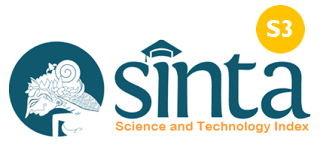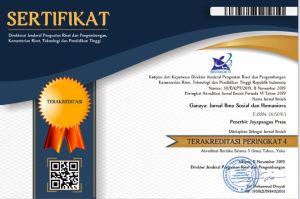Pola Pembelajaran Pendidikan Agama Hindu Di Utama Widya Pasraman Sila Kertha Raharja Jembrana
DOI:
https://doi.org/10.37329/cetta.v5i4.3109Keywords:
Learning Outcomes, Pasraman, Learning PatternsAbstract
Education is the most important priority in a country in order to improve the nation's intelligence and good morals. In Indonesia, education has been prioritized with 9 years of compulsory education in order to eradicate ignorance and poverty, with an intelligent society and noble morals that can guarantee a better life. Considering the importance of education and learning patterns for the younger generation. The existence of schools with Hindu nuances is to maintain the continuity of Hinduism in the future. The presence of Utama Widya Pasraman Sila Kertha Raharja in Jembrana as a school with a Hindu nuance can answer the needs of the Hindu community for education based on Hindu religious teachings. Utama Widya Pasraman Sila Kertha Raharja aims to instill in children a sense of love for the religion they adhere to, namely Hinduism as an implementation of Tri hita karana. This research uses a qualitative approach method. Qualitative research is research that is descriptive in nature and tends to use analysis. UWP Jembrana is a pasraman with Hindu religious auspices. The high school that was founded by Pasraman and pioneered from the beginning until now is still in the process of adding buildings to be erected at the school. The learning pattern applied at UWP Jembrana is predominantly taught material related to religion such as ethics, morality, tattwa, yoga, Kawi language, etc. In extracurricular activities, students will be divided into two groups, namely the male student group and the female student group.References
Al-Qahtani, M. M. Z., Abdulla, M. A. Z., Qaralleh, T. J. O., & Mawad, G. S. E. (2022). Teaching Strategies Adopted in Prince Sattam bin Abdulaziz University and the Extent of its Consistence with the University Prevailing Learning Patterns. Journal of Educational and Social Research, 12(6), 164–183.
Allen, S. J., & Hartman, N. S. (2009). Sources of learning in student leadership development programming. Journal of Leadership Studies, 3(3), 6–16.
Chiva, R., Alegre, J., & Lapiedra, R. (2007). Measuring organisational learning capability among the workforce. International Journal of Manpower, 28(3–4), 224–242.
Darmadi, H. (2018). Educational Management Based on Local Wisdom (Descriptive Analytical Studies of Culture of Local Wisdom in West Kalimantan). JETL (Journal Of Education, Teaching and Learning), 3(1), 135.
Hasanah, V. R., Ardiwinata, J. S., Jubaedah, Y., Ariani, I. P., & Ardiyanto, A. P. D. (2022). The Role of Community Mobilizers in Family Economic Empowerment. Edukasi, 16(2), 153–158.
Horban, O., Kravchenko, O., Martych, R., & Yukhymenko, N. (2019). The regulatory functions of education in behavioral models. Naukovyi Visnyk Natsionalnoho Hirnychoho Universytetu, 2019(3), 152–157.
Idris, R. (2013). Pendidikan Sebagai Agen Perubahan Menuju Masyarakat Indonesia Seutuhnya. Lentera Pendidikan : Jurnal Ilmu Tarbiyah Dan Keguruan, 16(1), 62–72.
Kadjeng, I. N. (1977). Sarasamuccaya. Surabaya: Paramita
Kelle, S., Klemke, R., & Specht, M. (2011). Design patterns for learning games. International Journal of Technology Enhanced Learning, 3(6), 555–569.
Mu’ti, A., & Amirrachman, A. (2021). Local Wisdom-Based Multicultural Education: Muhammadiyah Experience.
Setiyaningsih, D., Rosmi, F., Santoso, G., & Virginia, A. (2020). Implementasi Pendidikan Karakter Dalam Pembelajaran PKn di Sekolah Dasar. DIKDAS MATAPPA: Jurnal Ilmu Pendidikan Dasar, 3(2), 279.
Suastini, N. W., & Sumada, I. M. (2022). Character Education in School Based on Local Wisdom. The Social Perspective Journal, 1(2).
Yan, H., & Li, Y. (2021). A Blended Grammar Learning System Featuring Unsupervised Pattern Discovery. International Journal of Emerging Technologies in Learning, 16(16), 21–34.
Yulita, Y., Suciati, S., & Suroyo, S. (2022). Implementation of Active Learning Approaches Using the Role Playing Method As Character Building Effort. Quantum Journal of Social Sciences and Humanities, 4(2), 70–81.
Downloads
Published
How to Cite
Issue
Section
License

This work is licensed under a Creative Commons Attribution-ShareAlike 4.0 International License.
An author who publishes in the Cetta : Jurnal Ilmu Pendidikan agrees to the following terms:
- Author retains the copyright and grants the journal the right of first publication of the work simultaneously licensed under the Creative Commons Attribution-ShareAlike 4.0 License that allows others to share the work with an acknowledgement of the work's authorship and initial publication in this journal
- Author is able to enter into separate, additional contractual arrangements for the non-exclusive distribution of the journal's published version of the work (e.g., post it to an institutional repository or publish it in a book) with the acknowledgement of its initial publication in this journal.
- Author is permitted and encouraged to post his/her work online (e.g., in institutional repositories or on their website) prior to and during the submission process, as it can lead to productive exchanges, as well as earlier and greater citation of the published work (See The Effect of Open Access).
Read more about the Creative Commons Attribution-ShareAlike 4.0 Licence here: https://creativecommons.org/licenses/by-sa/4.0/.





